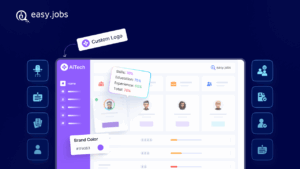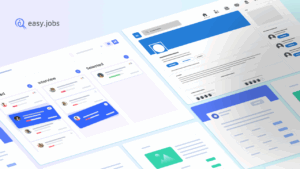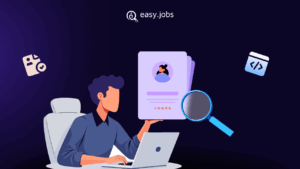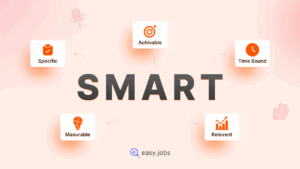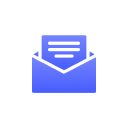Is your recruitment process a time and money drain? Manual screening and scheduling delays not only cost hours but also lead to expensive mis-hires. AI in talent acquisition transforms this operational drag into a high-return investment. This guide provides the exact formulas to calculate and prove its value to your stakeholders.

The New Talent Landscape: A Market in Transformation
The world of talent acquisition is undergoing a seismic shift, driven by technological advancement and intensifying competition for skilled professionals. The use of AI in recruiting has rapidly evolved from an innovative concept to an essential business tool.
Current market data reveals a clear and accelerating trend: more than one-third of companies have already integrated AI into their hiring processes. This adoption is not a fleeting phase; the market is projected to expand at a compound annual growth rate (CAGR) of 6.17% through 2030, signaling a fundamental change in how organizations build their workforces.
This technological pivot is a direct response to a critical business challenge. According to a survey of business leaders, 57% identified attracting and recruiting talent as a top operational challenge, underscoring the high stakes involved in the modern war for talent.
The strategic importance of this function is further highlighted by the fact that among companies experimenting with AI or Generative AI, 70% are applying it within their Human Resources departments, with talent acquisition being the number one use case. This widespread focus indicates that leaders view AI not as a peripheral technology but as a core solution to one of their most pressing problems.
The urgency of this transformation is magnified by the speed at which the talent market now operates. Research from ERE indicates that the best candidates are often off the market in as little as ten days. In stark contrast, the global average time-to-hire through traditional methods stands at a lengthy 44 days.
This disparity creates a significant competitive disadvantage for organizations relying solely on manual processes. AI-powered tools have been shown to reduce time-to-hire by as much as 75% in some cases.
Therefore, the speed advantage conferred by AI is not merely an incremental efficiency gain; it is a strategic weapon that directly determines whether a company can identify, engage and secure top-tier candidates before its rivals. In this context, the return on investment is not just measured in saved time, but in the acquisition of superior human capital that drives innovation and growth.
Demystify AI in Recruiting: From Buzzword to Business Tool

To understand the value of AI in recruiting, it is essential to move beyond the hype and establish a clear, business-focused definition of AI. At its core, AI in recruiting is the application of technologies, such as machine learning (ML), natural language processing (NLP) and large language models (LLMs), to automate, augment and enhance various stages of the talent acquisition lifecycle.
These systems are designed to analyze vast datasets to identify patterns, predict outcomes, and optimize workflows, ultimately supporting more intelligent hiring decisions. A common misconception is that AI is intended to replace human recruiters. The evidence, however, points to a symbiotic relationship.
AI serves as a powerful tool to augment the capabilities of talent professionals, not to render them obsolete. By automating the high-volume, repetitive tasks that consume a significant portion of a recruiter’s day, AI frees them to focus on high-value, uniquely human activities: building authentic relationships with candidates, assessing cultural alignment and serving as strategic talent advisors to hiring managers.
The functions of AI can be mapped across the entire hiring funnel. At the top of the funnel, AI-powered sourcing tools scan millions of profiles across disparate platforms to identify qualified passive and active candidates. During the screening phase, AI algorithms analyze resumes and applications against job requirements with speed and consistency that is impossible for humans to replicate.
AI chatbots enhance candidate engagement by answering questions and providing updates 24/7. Further down the funnel, AI automates interview scheduling and provides predictive analytics to forecast hiring success. This transforms recruiting into a streamlined, data-driven operation, replacing manual steps with efficient automation.
The Core Problem AI Solves: Overcome Inefficiency and Human Limitations
Traditional recruiting methodologies are increasingly ill-equipped to handle the demands of the modern talent market. The process is notoriously time-consuming, susceptible to unconscious human bias and often breaks down under the weight of high application volumes.
For instance, more than half of all recruiters report that shortlisting candidates from a large applicant pool is the most difficult part of their job. These challenges not only create operational bottlenecks but also lead to significant rates of recruiter burnout, with most recruiters citing repetitive administrative work as the primary cause. If you find out the core problem AI solves, you can stay ahead of the curve with your competitors.
AI directly addresses these fundamental limitations. It excels at processing thousands of applications in minutes, a task that would take human teams weeks to complete. By applying standardized, objective criteria to every candidate, AI systems can significantly reduce the impact of unconscious bias related to factors like age, gender, or educational background, thereby promoting more equitable and diverse hiring outcomes.
Furthermore, the very process of preparing for an AI implementation forces a level of strategic discipline that yields benefits on its own. Successful AI deployment is contingent on the availability of high-quality, clean, and unbiased data.
To achieve this, organizations must first conduct a thorough audit of their existing talent acquisition workflows, standardize their processes and define clear, measurable objectives for the technology.
This preparatory phase compels a strategic introspection and process optimization that strengthens the entire talent function. The initial “cost” of data cleanup and process mapping is, in effect, a down payment on a more disciplined, data-fluent and effective recruiting organization, generating value even before the first AI-driven insight is delivered.
The Value Proposition: A Data-Backed Analysis of AI’s Impact
The business case for investing in AI for recruiting is built on four pillars of value: operational efficiency, financial returns, talent quality and stakeholder experience. Each pillar is supported by a wealth of data and real-world results, demonstrating a clear and compelling impact on key business metrics.
Pillar 1: Supercharge Operational Efficiency
The most immediate and widely recognized benefit of AI in recruiting is a dramatic improvement in operational efficiency. AI achieves this by automating the most time-consuming and repetitive tasks that bog down talent acquisition teams.
- Time Savings: AI algorithms can screen resumes, write initial drafts of job descriptions, and automate email drip campaigns, freeing recruiters from administrative burdens. On average, recruiters save 4.5 hours per week by using AI for these tasks. This saved time is then reallocated to more strategic activities, such as engaging with top candidates and consulting with hiring managers.
The scale of this impact is exemplified by global consumer goods company Unilever, which saved over 100,000 hours of human recruitment time annually after implementing AI-driven assessment tools.
- Reduced Time-to-Hire: By accelerating every stage of the funnel, from sourcing to scheduling, AI significantly shortens the overall hiring cycle. This is a critical advantage in a market where competitors quickly secure top talent.
- Increased Recruiter Productivity: With administrative work handled by AI, recruiters can manage a larger volume of requisitions without sacrificing quality. This multiplies the productivity of the existing team.
Recruiters who leverage automation in their processes fill, on average, more vacancies than those who do not. This allows organizations to scale their hiring efforts without a proportional increase in headcount.
Pillar 2: Deliver Tangible Financial Returns
The efficiency gains driven by AI translate directly into significant financial benefits, making the technology a sound investment with a clear path to positive ROI.
- Reduced Cost-per-Hire: Faster, more efficient processes naturally lead to lower costs. By automating tasks and optimizing workflows, AI can reduce overall recruitment costs by a signification amount in conservative implementations.
This reduction stems from fewer hours spent per hire, optimized spending on job boards through programmatic advertising and a decreased need for temporary staff during hiring surges.
- Mitigating the Cost of Mis-Hires: A bad hire is one of the most expensive mistakes a company can make, with potential costs estimated to be as high as many times the candidate’s compensation when factoring in lost productivity, training expenses and negative impacts on team morale.
AI analytics can predict a candidate’s likelihood of success based on a deep analysis of their skills, experience and alignment with the profiles of successful current employees. This data-driven approach helps organizations avoid costly hiring errors and build stronger more effective teams.
- Decreased Agency Spend: Many organizations rely on costly external recruitment agencies to fill critical roles. AI-powered recruitment platforms, like easy.jobs, enable companies to build robust internal talent pipelines by proactively identifying and engaging with passive candidates. By developing a rich, internal database of qualified talent, companies can significantly reduce their reliance on and expenditure for third-party agencies.
Pillar 3: Elevate Talent Quality and Diversity
Beyond efficiency and cost savings, AI has a profound impact on the quality and composition of the workforce.
- Improved Quality of Hire: AI moves talent assessment beyond simple keyword matching. Modern systems use machine learning to analyze complex patterns in a candidate’s career trajectory, identify validated and likely skills and predict their potential for success in a specific role.
This leads to better-matched, higher-performing, and longer-tenured employees. The impact is substantial, with companies using AI in their recruitment processes improving the quality of their hires.
- Bias Reduction: Unconscious human-created recruitment bias is a persistent challenge in traditional recruiting. AI systems can be programmed to ignore demographic information such as gender, race and age, focusing exclusively on objective, job-relevant criteria like skills and experience.
This promotes fairer, more consistent evaluation and helps organizations build a more diverse and inclusive workforce. After using AI to analyze and remove biased language from its job descriptions, you will see an increase in the diversity of your candidate pool.
- Uncovering Hidden Talent: Human recruiters, often under pressure, may inadvertently overlook highly qualified candidates who have non-traditional career paths or resumes that are not perfectly optimized with keywords.
AI algorithms can analyze a candidate’s profile holistically, identifying transferable skills and relevant experiences that a manual review might miss, thereby uncovering hidden gems in the talent pool.
Pillar 4: Enhance the Stakeholder Experience
AI implementation positively impacts the experience of all key stakeholders in the hiring process, from candidates to recruiters.
- Improved Candidate Experience: In a competitive market, candidate experience is a key differentiator. AI-powered chatbots provide 24/7 engagement, instantly answering candidate questions, providing status updates and guiding them through the application process.
This responsiveness prevents high-potential candidates from dropping out due to slow or non-existent communication. For instance, L’Oréal implemented an AI chatbot that led to a significant decrease in their application drop-off rate and higher candidate satisfaction scores.
- Empowering the Recruiter: Rather than devaluing the role, AI elevates it. By automating administrative and repetitive work, AI empowers recruiters to transition from being process administrators to strategic talent advisors.
They can dedicate more time to building meaningful relationships with candidates, providing expert consultation to hiring managers and focusing on long-term talent strategy, making their work more impactful and rewarding.
The following table summarizes the multifaceted value proposition of integrating AI into the recruitment function, providing a clear overview of its impact.
| Value Pillar | Key Benefit | Quantifiable Impact |
| Operational Efficiency | Time Savings | Recruiters save an average of 4.5 hours per week. Unilever saved over 100,000 hours of recruitment time annually. |
| Reduced Time-to-Hire | Accelerates every stage of the funnel for a shorter hiring cycle. | |
| Increased Recruiter Productivity | Recruiters can manage a larger volume of requisitions and fill more vacancies. | |
| Financial Returns | Reduced Cost-per-Hire | Lowers costs through fewer hours spent per hire and optimized ad spending. |
| Mitigating Cost of Mis-Hires | Helps avoid costly hiring errors through data-driven predictions of candidate success. | |
| Decreased Agency Spend | Builds robust internal talent pipelines, reducing the need for costly external agencies. | |
| Talent Quality & Diversity | Improved Quality of Hire | Leads to better-matched, higher-performing, and longer-tenured employees. |
| Bias Reduction | Can lead to an increase in the diversity of the candidate pool by removing biased language. | |
| Uncovering Hidden Talent | Holistically analyzes profiles to find qualified candidates with non-traditional career paths. | |
| Stakeholder Experience | Improved Candidate Experience | 24/7 chatbot engagement provides instant updates and answers. L’Oréal saw a significant decrease in their application drop-off rate. |
| Empowering the Recruiter | Allows recruiters to become strategic advisors by automating administrative work. |
The ROI Blueprint: A Step-by-Step Guide to Calculate the Value of AI

Calculating the Return on Investment (ROI) for AI in recruiting is essential for justifying the initial expenditure and for demonstrating ongoing value to stakeholders. A robust ROI analysis goes beyond simple cost savings to encompass a holistic view of the technology’s impact.
This five-step blueprint provides a practical framework for measuring the actual value of an AI implementation.
Step 1: Establish Your Baseline – Measure Before You Manage
The foundational principle of any ROI calculation is establishing a clear and accurate baseline. Without a comprehensive understanding of pre-implementation performance, it is impossible to measure the impact of a new technology credibly.
This initial step involves meticulously documenting key performance indicators (KPIs) across the entire talent acquisition function. Essential baseline metrics to capture include:
- Time-Based Metrics:
- Average Time-to-Fill: The number of calendar days from the approval of a job requisition to the acceptance of an offer. This measures the entire lifecycle.
- Average Time-to-Hire: The number of days from when a candidate enters the pipeline (e.g., applies) to when they accept an offer. This measures the velocity of the candidate journey.
- Cost-Based Metrics:
- Cost-per-Hire (CPH): A comprehensive calculation that includes all internal costs (recruiter salaries, referral bonuses) and external costs (job board fees, agency fees, background checks) helps you to get the actual cost per hire.
- Quality-Based Metrics:
- Quality of Hire: Often measured through a combination of first-year performance review scores, hiring manager satisfaction surveys and new hire retention rates at the 6 and 12-month marks.
- First-Year Attrition Rate: The percentage of new hires who leave the organization within their first year. This is a powerful indicator of hiring effectiveness.
- Efficiency-Based Metrics:
- Source of Hire: The percentage of hires coming from various channels (e.g., job boards, agencies, referrals) and the associated costs and quality of each channel.
- Offer Acceptance Rate (OAR): The percentage of extended offers that candidates accept. A low OAR can indicate issues in the process or compensation strategy.
- Recruiter Workload: The average number of open requisitions managed per recruiter at any given time.
Step 2: Quantify the Investment – The “I” in ROI
To calculate ROI, a complete accounting of all associated costs, the investment is required. This extends beyond the software’s sticker price to include all resources allocated to the project.
- Direct Costs: This is the most straightforward component, primarily consisting of the software subscription fees. Pricing models for these tools are highly variable, ranging from affordable plans suitable for small businesses to significant enterprise-level license fees for more comprehensive solutions.
- Implementation and Integration Costs: Many enterprise systems involve one-time fees for initial setup, data migration from legacy systems and technical integration with the existing Applicant Tracking System (ATS) like easy.jobs or Human Resource Information System (HRIS).
- Indirect Costs: These “soft” costs are often overlooked but are critical for an accurate calculation. They include the value of the time spent by the recruiters and IT teams on training, change management initiatives to ensure user adoption and any temporary dips in productivity as recruiters adapt to new workflows and the system’s learning curve.
Step 3: Calculate Tangible Returns – The “R” in ROI
With a baseline established and total investment calculated, the next step is to quantify the financial gains generated by the AI system. This can be broken down into several key formulas.
Formula A: Calculate the Value of Time Savings
This formula converts efficiency gains into a monetary value.
(Hours Saved per Hire)×(Number of Hires)×(Average Fully-Loaded Recruiter Hourly Rate)=Total Time Savings Value
For example, if AI saves 20 hours per hire and the company makes 100 hires a year with recruiters whose fully-loaded cost is $50/hour, the savings would be $100,000. A more dramatic example from one analysis showed a company saving 16,000 recruiter hours on 100 hires, translating to an $800,000 value.
Formula B: Calculate Direct Cost Reduction
This formula measures the direct cost reduction in recruitment-related expenses.
(Baseline Cost-per-Hire−Post-AI Cost-per-Hire)×(Number of Hires)=Total Cost Savings
This calculation should include concrete savings from reduced spending on external recruitment agencies, lower advertising costs on job boards and decreased administrative overhead.
Formula C: Calculate the Value of Improved Quality of Hire
Quantifying the value of a better hire is challenging but crucial. A simplified model can provide a conservative estimate by focusing on the reduction of costly turnover.
(Value of Avoiding a Mis-Hire)×(Reduction in First-Year Attrition Rate)×(Number of Hires)=Quality of Hire Value
The “Value of Avoiding a Mis-Hire” can be estimated as a multiple of the employee’s annual salary, with some sources suggesting the true cost can be exceptionally high. Even a modest reduction in the first-year attrition rate can yield substantial financial returns.
It is important to recognize that this traditional approach to calculating the return on a quality hire is inherently limited. Standard ROI formulas often treat the “return” as a static, one-time event, such as the value of an employee’s salary in their first year.
This model fails to capture the compounding value that a superior employee brings to an organization over their entire tenure. A high-quality hire, identified more effectively by AI, does not just produce at a baseline level; they innovate, mentor colleagues, elevate team performance and may develop into future leaders.
Their true value grows exponentially over time. Therefore, a more sophisticated analysis should frame the return in terms of Employee Lifetime Value (ELV). This reframes the conversation with financial stakeholders, moving it from a short-term cost-benefit analysis to a discussion about a long-term strategic investment in human capital that fuels sustainable growth.
Step 4: Putting It All Together – The Final ROI Calculation
The final step is to synthesize the gains and investments into the standard ROI formula to produce a clear, compelling percentage.
ROI%=Total Investment Cost(Total Financial Gain−Total Investment Cost)×100
To illustrate, consider a hypothetical scenario based on an example from the research.
- Total Financial Gain: $800,000 (from time savings) + $100,000 (from reduced agency fees) = $900,000
- Total Investment Cost: $200,000 (annual software subscription and support)
- Calculation:
ROI%=$200,000($900,000−$200,000)×100=$200,000$700,000×100=350%
This result demonstrates that for every dollar invested in the AI platform, the company generated $3.50 in net returns.
Step 5: Articulate Strategic (Intangible) Returns
A purely financial calculation, while powerful, does not capture the full spectrum of value. The business case should be enriched with a narrative that articulates the strategic, or intangible, returns.
- Enhanced Employer Brand: A modern, efficient and responsive hiring process powered by AI improves the company’s reputation among candidates. This can be tracked through metrics like application completion rates and sentiment analysis on employer review sites like Glassdoor.
- Improved Diversity, Equity, and Inclusion (DEI) Outcomes: AI’s ability to standardize screening can lead to a more diverse workforce. This should be demonstrated by tracking the demographic composition of candidate pipelines and hires over time.
- Fostering a Data-Driven Talent Culture: The implementation of AI shifts the talent acquisition function from one based on intuition and “gut feel” to one grounded in data and analytics. This leads to more strategic and defensible hiring decisions.
- Sustained Competitive Advantage: In a fast-moving talent market, the speed, quality and efficiency provided by AI are not just operational improvements but key components of a long-term competitive strategy.
The very act of tracking these metrics for an ROI calculation provides an additional, powerful benefit. The data collected serves as a continuous diagnostic tool for the entire talent acquisition function.
For example, a low Offer Acceptance Rate might not be a failure of the AI tool but could indicate that compensation packages are not competitive or that the interview process is flawed. Similarly, a high application drop-off rate could reveal a clunky, non-mobile-friendly application portal.
In this way, the process of measuring AI’s ROI creates a valuable feedback loop that surfaces weaknesses and opportunities for improvement across the entire recruitment lifecycle, making the investment in measurement doubly valuable.
Select the Right Technology Partner to Maximize Your Return

The market for AI recruiting software is dynamic and crowded, with a vast array of vendors offering solutions that address different aspects of the talent acquisition lifecycle. Choosing the right technology partner is critical to achieving the desired ROI.
A successful selection process involves mapping specific business needs to the appropriate tool category and rigorously evaluating vendors against a checklist of key criteria.
Map AI Tools to Your Needs
The AI recruiting software landscape can be segmented into several key categories based on their primary function. Understanding these categories allows an organization to pinpoint the type of solution that will address its most pressing challenges.
- Comprehensive Platforms (ATS/CRM with AI): These are end-to-end systems designed to manage the entire recruitment process, from sourcing to onboarding. They often serve as the central system of record for all talent acquisition activities. They are best suited for organizations looking for a complete transformation of their recruiting function or those replacing a legacy ATS. Examples include easy.jobs, Workable etc.
- Specialist AI for candidate sourcing Tools: These hiring platforms are purpose-built to excel at finding and engaging passive talent. They leverage AI to search across vast databases (like LinkedIn, GitHub, and the open web) and use intelligent matching to surface candidates who are not actively applying for jobs. They are ideal for companies in competitive industries or those hiring for hard-to-fill technical roles.
- Candidate Engagement & Screening Tools: These tools focus on the top of the funnel, particularly for high-volume hiring environments. They typically feature conversational AI chatbots (like easy.jobs AI Screening) and automated smart workflows to efficiently manage thousands of applicants, answer their questions, and identify the most qualified individuals for progression.
- Assessment & Interviewing Tools: This category includes platforms that use AI to improve the quality and consistency of candidate evaluation. They offer features like AI-analyzed one-way video interviews, gamified skills assessments and predictive analytics to gauge a candidate’s potential for success. They are best for organizations prioritizing quality of hire and seeking to standardize their screening process.
The Buyer’s Checklist: Key Features to Evaluate
Once the appropriate category of tool has been identified, organizations should use a detailed checklist to evaluate potential vendors. This ensures that the chosen solution is not only powerful but also secure, compliant and user-friendly.
- Integration Capabilities: A critical factor is the tool’s ability to seamlessly integrate with the company’s existing technology stack, particularly the central ATS and HRIS. Poor integration creates data silos and inefficient workflows, undermining the potential benefits of the new tool.
- Bias Mitigation and Auditing: Given the potential for AI to inherit and amplify biases from historical data, vendors must be able to demonstrate robust, proactive measures to combat this risk. Inquire about the specific features used to detect and mitigate algorithmic bias, the frequency of bias audits and compliance with regulations like New York City’s Local Law 144, which governs automated employment decision tools.
- Explainability and Transparency: A “black box” AI is a significant risk. The system should be able to provide a clear rationale for its decisions, such as explaining why it ranked a particular candidate as a strong match. This “explainable AI” is crucial for building trust with recruiters and ensuring the process is defensible.
- Data Security and Compliance: The platform must adhere to stringent data privacy and security standards. It should be fully compliant with relevant regulations, such as the General Data Protection Regulation (GDPR) in Europe and the California Consumer Privacy Act (CCPA), to protect sensitive candidate information.
- Scalability and Customization: The software should be able to grow with the organization. It needs to handle increasing hiring volumes and allow for the customization of workflows to match the company’s unique recruitment processes.
- User Experience (UX): The platform must be intuitive and easy to use for both recruiters and candidates. A clunky interface will lead to low adoption among the recruiting team, while a poor candidate-facing experience can deter top talent and damage the employer brand.
Understand the Cost Spectrum
To set realistic budget expectations, it is important to understand the common pricing models in the AI recruiting software market. Costs vary widely based on the vendor, feature set, and scale of the deployment.
Common models include per-user-per-month subscriptions, tiered plans based on the number of active jobs or features and custom annual contracts for enterprise-level clients that often include implementation and dedicated support services.
A thorough evaluation should include a clear understanding of the total cost of ownership, encompassing subscription fees, implementation charges and any necessary add-ons.
Build Your Business Case for a High-ROI AI Strategy in Hiring
Artificial Intelligence is no longer a futuristic idea in talent acquisition; it is a present-day necessity for any competitive recruitment strategy. AI delivers tangible value by driving massive operational efficiencies, generating clear financial returns, and improving the quality and diversity of hires.
In current world of recruitment data-driven landscape using AI has become essential for winning the war for talent. Crucially, the narrative has shifted from AI replacing recruiters to a more powerful one: AI empowers them. By automating the repetitive, administrative tasks that lead to burnout, AI elevates the role of a talent professional.
This transforms their function from a transactional process into a strategic pillar, allowing them to focus on building relationships and advising leadership. The path to a positive return on investment is clear; the next step is building your business case. Found this guide helpful? Subscribe to our blog for expert insights on leveraging AI and crafting a winning HR strategy. For real-time discussions, join our Facebook Community to connect with peers and get answers to your most pressing questions.

